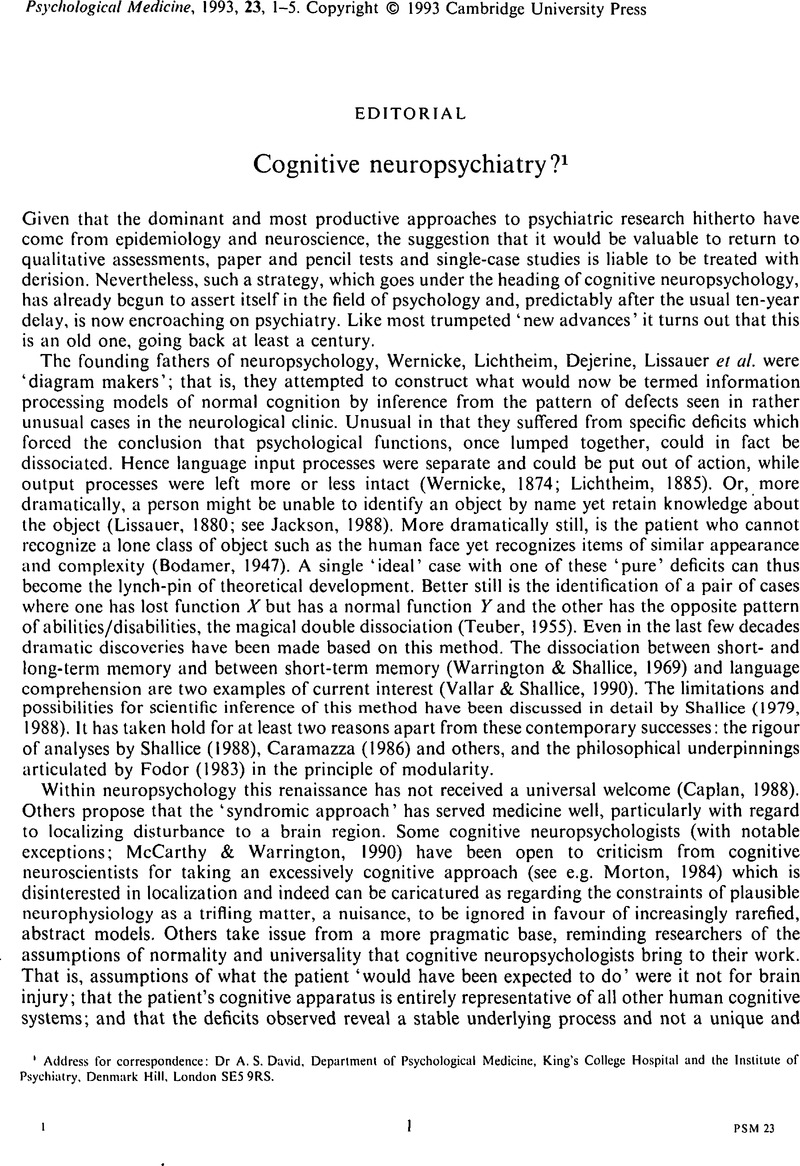Crossref Citations
This article has been cited by the following publications. This list is generated based on data provided by Crossref.
Buckley, Peter F.
1993.
Functional Psychoses Is the Concept Disintegrating?.
Psychosomatics,
Vol. 34,
Issue. 5,
p.
462.
David, Anthony
Blamire, Andrew
and
Breiter, Hans
1994.
Functional Magnetic Resonance Imaging.
British Journal of Psychiatry,
Vol. 164,
Issue. 1,
p.
2.
David, Anthony
1995.
The Future of Diagnosis.
British Journal of Psychiatry,
Vol. 167,
Issue. 2,
p.
155.
Charlton, Bruce G.
1995.
Cognitive Neuropsychiatry and the Future of Diagnosis: a ‘PC’ Model of the Mind.
British Journal of Psychiatry,
Vol. 167,
Issue. 2,
p.
149.
Phillips, M.L.
and
David, A.S.
1995.
Facial processing in schizophrenia and delusional misidentification: cognitive neuropsychiatric approaches.
Schizophrenia Research,
Vol. 17,
Issue. 1,
p.
109.
1996.
Editorial.
Cognitive Neuropsychiatry,
Vol. 1,
Issue. 1,
p.
1.
Laws, Keith R
McKenna, Peter J
and
McCarthy, Rosaleen A
1996.
Reconsidering the Gospel According to Group Studies: A Neuropsychological Case Study Approach to Schizophrenia.
Cognitive Neuropsychiatry,
Vol. 1,
Issue. 4,
p.
319.
Phillips, Mary L.
1996.
"Mirror, Mirror on the Wall, Who...?": Towards a Model of Visual Self-recognition.
Cognitive Neuropsychiatry,
Vol. 1,
Issue. 2,
p.
153.
Nayani, Tony H.
and
David, Anthony S.
1996.
The auditory hallucination: a phenomenological survey.
Psychological Medicine,
Vol. 26,
Issue. 1,
p.
177.
Bentall, Richard P
1996.
Editorial At the Centre of a Science of Psychopathology? Characteristics and Limitations of Cognitive Research.
Cognitive Neuropsychiatry,
Vol. 1,
Issue. 4,
p.
265.
Kopelman, M. D
1996.
Opinion What’s Wrong and What’s Right in Neuropsychology and Neuropsychiatry.
Cognitive Neuropsychiatry,
Vol. 1,
Issue. 4,
p.
275.
Phillips, Mary L
and
David, Anthony S
1997.
Visual scan paths are abnormal in deluded schizophrenics.
Neuropsychologia,
Vol. 35,
Issue. 1,
p.
99.
Walston, Florence
David, Anthony S.
and
Charlton, Bruce G.
1998.
Sex Differences in the Content of Persecutory Delusions.
Evolution and Human Behavior,
Vol. 19,
Issue. 4,
p.
257.
Brasić, James Robert
1998.
Hallucinations.
Perceptual and Motor Skills,
Vol. 86,
Issue. 3,
p.
851.
Phillips, Mary L.
and
David, Anthony S.
1998.
Abnormal visual scan paths: a psychophysiological marker of delusions in schizophrenia.
Schizophrenia Research,
Vol. 29,
Issue. 3,
p.
235.
Kerns, John G.
Berenbaum, Howard
Barch, Deanna M.
Banich, Marie T.
and
Stolar, Neal
1999.
Word production in schizophrenia and its relationship to positive symptoms.
Psychiatry Research,
Vol. 87,
Issue. 1,
p.
29.
Cummings, Jeffrey L.
1999.
Principles of neuropsychiatry: Towards a neuropsychiatric epistemology.
Neurocase,
Vol. 5,
Issue. 3,
p.
181.
Halligan, Peter W.
and
David, Anthony S.
1999.
Conversion Hysteria: Towards a Cognitive Neuropsychological Account.
Cognitive Neuropsychiatry,
Vol. 4,
Issue. 3,
p.
161.
Langdon, Robyn
and
Coltheart, Max
1999.
Mentalising, schizotypy, and schizophrenia.
Cognition,
Vol. 71,
Issue. 1,
p.
43.
Nieuwenstein, Mark R.
Aleman, André
and
de Haan, Edward H.F.
2001.
Relationship between symptom dimensions and neurocognitive functioning in schizophrenia: a meta-analysis of WCST and CPT studies.
Journal of Psychiatric Research,
Vol. 35,
Issue. 2,
p.
119.





